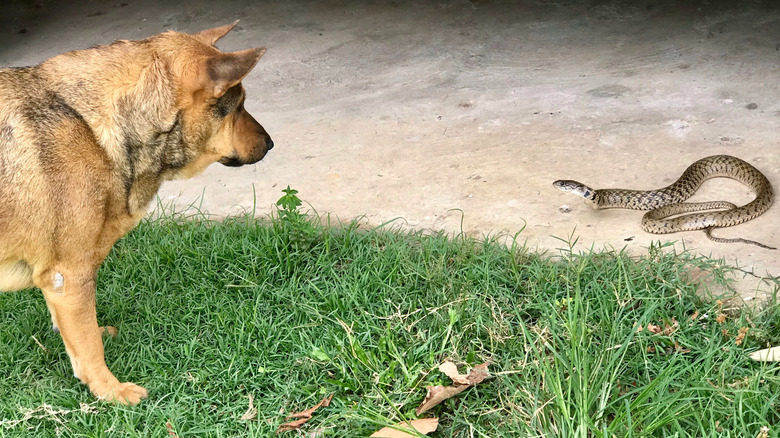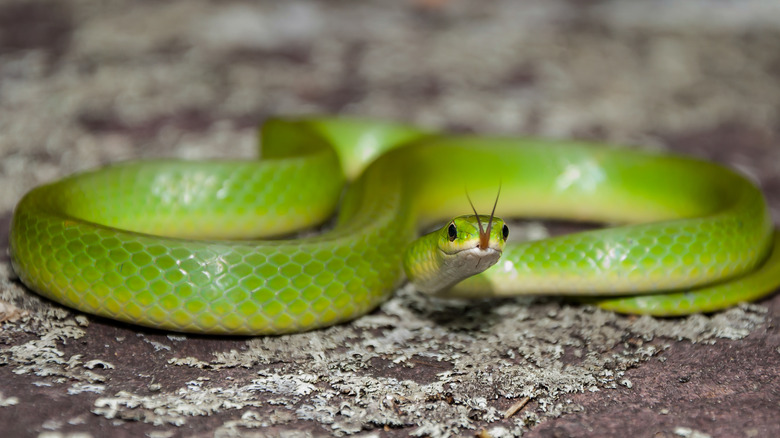Is It Cause For Concern If Pet Owners See A Grass Snake Slithering In The Lawn?
At first glance, any scaly, legless reptile who drops by your yard will give most people a jolt of fright. Grass snakes are generally known to be harmless. But as it winds through your lawn, how can you know you're dealing with a gentle snake versus a venomous one? And are your pets in danger with these creatures hanging around? Don't fret, because these docile snakes aren't a threat to our four-legged family members — or us, for that matter.
Depending on whether you're in North America or Eurasia, what's considered a "grass snake" is quite different. It will be a relief to be able to identify the beast slithering by as a non-threatening backyard visitor, so even if you have a snake problem on your hands, it may at least not be a dangerous one. If it's grass snakes, you don't have much of a problem, but here's how to identify the risk-free reptiles.
How do you tell if a snake is a grass snake?
The animals called "grass snakes" in North America and Europe are entirely separate species. If you live in North America, you're dealing with a species called Opheodrys vernalis, a dazzlingly green snake also not surprisingly known as a smooth green snake. American grass snakes make their homes in a wide range of areas, with the bulk of their population being found in the northeast of the U.S. crossing over to the southeast of Canada, as well as some isolated regions of the Rockies, the southwest, and even as far south as Mexico. These brightly-colored snakes are easy to identify, since they are the only snakes to have solid green backs. Their preferred habitat are open spaces like fields, and near bogs, marshes, and open water. You may also spy one taking a break on a low tree branch.
In Europe, North Africa, or parts of Asia, grass snakes are a species called Natrix natrix. These benign buddies aren't widespread in Asia, but they have been found in the Middle East, parts of Mongolia, and northwest China. Also known as water snakes or ringed snakes, these grass snakes are usually dark green or dark brown with off-white or light-yellow bands around their neck. The neck band may not entirely encircle its body, often having a darker marking that interrupts the band at the top of its neck. Like their distant American relatives, Eurasian grass snakes often live near a water source, so if your property doesn't have one, it's less probable that one will have a nest nearby.
Can grass snakes harm your pet?
Pet parents are often just as cautious about their furry children as human parents are for their actual offspring. With your ongoing tasks of making your patio and yard pet-friendly, you can check one worry off the list when it comes to grass snakes.
Cold-blooded, quiet, and even cute, both Opheodrys vernalis and Natrix natrix snakes are timid and safe to have around. American smooth green snakes are fans of insects, mollusks, and the occasional amphibian. Eurasian grass snakes eat mainly amphibians but also enjoy earthworms or young rodents. Grass snakes of either kind are non-venomous and almost never bite. In the very unlikely event of a bite, the only harm that can come is a little pain and maybe an infection if the bite area isn't cleaned quickly. Due to their fur, it can be hard to see if a dog or cat was bitten by a snake.
However, if a snake bites your pet and you're not 100% certain which kind of snake is the culprit, contact your vet immediately. If you'd rather not take the chance that the scaly critter in your grass is dangerous, try our foolproof ways to keep snakes from slithering around your yard. Yet, you might want to encourage smooth green snakes to stick around too, since they can help control your bug population.


